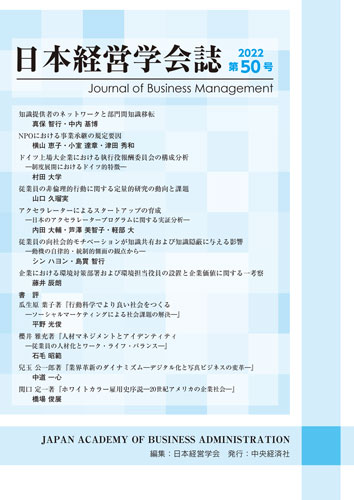Volume 50
Displaying 1-15 of 15 articles from this issue
- |<
- <
- 1
- >
- >|
JOURNAL OF BUSINESS MANAGEMENT No.50
-
2022 Volume 50 Pages 1-2
Published: August 25, 2022
Released on J-STAGE: August 26, 2023
Download PDF (769K)
-
2022 Volume 50 Pages 3-16
Published: August 25, 2022
Released on J-STAGE: August 26, 2023
Download PDF (1609K) -
2022 Volume 50 Pages 17-30
Published: August 25, 2022
Released on J-STAGE: August 26, 2023
Download PDF (1087K) -
2022 Volume 50 Pages 31-44
Published: August 25, 2022
Released on J-STAGE: August 26, 2023
Download PDF (1008K) -
2022 Volume 50 Pages 45-58
Published: August 25, 2022
Released on J-STAGE: August 26, 2023
Download PDF (1148K) -
2022 Volume 50 Pages 59-72
Published: August 25, 2022
Released on J-STAGE: August 26, 2023
Download PDF (1433K) -
2022 Volume 50 Pages 73-86
Published: August 25, 2022
Released on J-STAGE: August 26, 2023
Download PDF (1378K) -
2022 Volume 50 Pages 87-98
Published: August 25, 2022
Released on J-STAGE: August 26, 2023
Download PDF (1024K)
-
2022 Volume 50 Pages 99-103
Published: August 25, 2022
Released on J-STAGE: August 26, 2023
Download PDF (899K) -
2022 Volume 50 Pages 104-108
Published: August 25, 2022
Released on J-STAGE: August 26, 2023
Download PDF (899K) -
2022 Volume 50 Pages 109-114
Published: August 25, 2022
Released on J-STAGE: August 26, 2023
Download PDF (996K) -
2022 Volume 50 Pages 115-119
Published: August 25, 2022
Released on J-STAGE: August 26, 2023
Download PDF (897K)
-
2022 Volume 50 Pages 120-125
Published: August 25, 2022
Released on J-STAGE: August 26, 2023
Download PDF (828K)
-
2022 Volume 50 Pages 126-127
Published: August 25, 2022
Released on J-STAGE: August 26, 2023
Download PDF (781K)
-
2022 Volume 50 Pages E1
Published: August 25, 2022
Released on J-STAGE: August 26, 2023
Download PDF (1199K)
- |<
- <
- 1
- >
- >|
